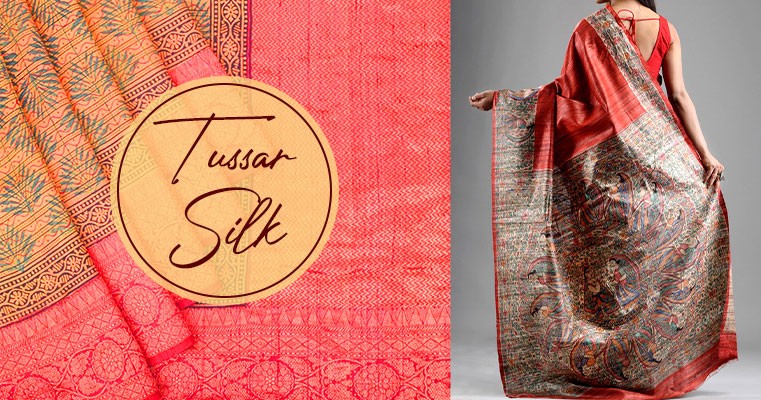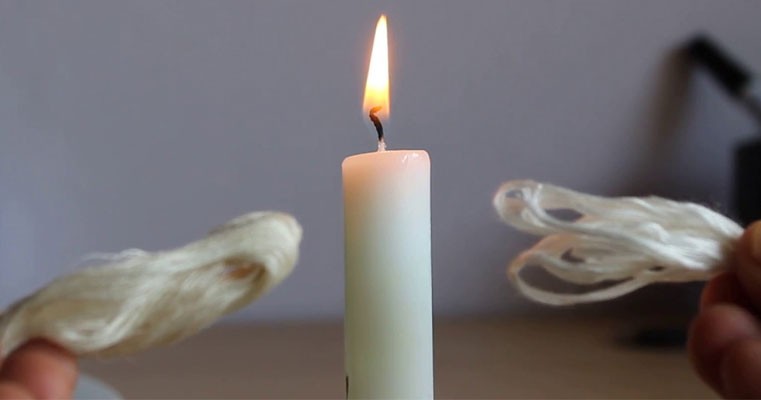The Art of Making Tussar Silk Sarees and Its Care

India is home to a variety of silks and the queen of them is the tussar silk that is found in the eastern parts of India principally in Chhattisgarh, WB, Odisha and Bihar. It is a popular drape and women find it posh in draping one. Here you will know how a tussar silk saree is developed and how a saree is made from it.
The charm of tribal artisans
The silk weaving process is a tedious job at hand. And the people from the eastern part of India are an expert in it. One look at the premium texture and sheerness of the tussar silk saree will tell you the talent level of these tribal artisans.
Types of tussar silk
The tussar means the shuttle derived from the age-old rich language Sanskrit, which is derived from the silkworm named Antheraea militia, which principally feeds on oak leaves. Well, most do not know that two types of tussar silk are found- tropical tussar (found in Jharkhand, Chattisgarh and WB) and temperate tussar (sub-Himalayan belts of Assam, Manipur and Meghalaya).s The temperate tussar is also known as Muga silk, principally grown in Assam Antheraea assamensis that primarily feeds on the castor plant. The temperate tussar is golden in colour, which sets it apart from the wild tussar silk grown primarily in Chattisgarh.
Local Habitation
These silkworms are grown on local trees like saja, Arjun or sal and that�s why they are primarily called wild silk and is known for their rich golden colour.
Characteristics
- It is less costly
- It is more durable than its other competitors
- Great golden colour
- It has a natural golden colour that is deep and rich
- Light and airy that offers great comfort level of wearing
- It is available in a plethora of shades and colours so there is no need to dye to find a suitable colour
Manufacturing process

Antheraea Yamamai, Antheraea Pernyi, Antheraca Proylei, and Antheraea mylitta are some of the silkworm species from which the Tussar Silk is derived. These insects are primarily found in the untamed forests, where they feed on the trees they dwell on. Their cocoons, which are single-shelled and oval, are gathered and boiled to extract the silk yarn. Boiling is a crucial element of the silk production process since it softens the cocoon and makes silk extraction easier. The cocoons are cooked with the larvae inside in traditional sericulture; however, if the cocoons are boiled after the larvae have left, the silk produced is known as 'Non-Violent Silk' or ahimsa silk.
Some facts on Tussar Silk Sarees
Maintenance
Many women do not have more than one or two tussar silk sarees in their wardrobe because these needs a lot of cautious maintenance steps to withheld the texture and softness of the tussar silk saree. So, knowing these little steps are important.
- Initial level of dry cleaning: There is a solid chance of colour bleeding post drycleaning especially in brand new tussar silk sarees. So, it is important to handwash your tussar silk at home which prevents colour bleeding during further wet washes.
- Solution preparation: A tussar silk saree is fit for handwashing post initial level of dry cleaning. And for handwashing prepare a solution of cold water with a mild detergent or washing powder which has a composition of lesser harmful chemicals.
- Soaking & wetting: It�s important to soak your tussar saree completely and wait for a few minutes before t is completely wetted.
- Enough movement: It is important to provide a proper cleaning of the garment. So, when you cold wash your tussar saree, move your tussar silk saree too and fro so that apart from preventing cold bleeding, it must cleanse the dirt from your saree.
- Reason for deterioration: Most women agree that too many detergent particles when left on your couture it deteriorates the texture of the item. The same is with tussar silks too. It is important to rinse your tussar silk nicely so that no detergent molecules will stay on these silky fibres else it will deteriorate the texture in no time.
- Being gentle is the key: It is important to take the water out of your tussar silk saree at all times. Leaving your tussar silk saree with a lot of water will damage the fibres intricately.
- Basic step: It is always vital to dry your silk sarees in shade rather than exposing them to sunlight.
Vital precautions
- Machine washing involves intense washing techniques which are unsuitable for a silk saree especially when it is a tussar silk saree.
- It is important to do handwashing only after it is dry-cleaned thoroughly, else there is a probability that it will amplify the colour bleeding process which in turn will hurt the quality of the tussar silk saree completely.
- Do not expose to direct sunlight at any cost
- Soft ironing is a great step to endure the softness and durability of the fabric.
How to avoid machine wash?
There are uncountable reasons when we subject our silk sarees to machine washes. It is important to know some simple hacks to get rid of stains and avoid machine washing. Let us see what they are:
- Lipstick stain: All you need is a white cloth, some tissues and a mild soap. Keep the tissues on the flat surface and keep your stained cloth upside down. Take the white cloth, damp it in mild soap solution and damp it on the backside of the stained area. This simple technique will absorb the lipstick stain in no time and there is no need to wash it in the washing machine too.
- Protein stains: These are caused by blood and sweat. And when you use the dry cloth to remove the stain and apply the mild soap this step will fade the stain. And if the stain does not fade, it is ideal to go for dry-cleaning quickly before it dries out completely.
- Ink stains: It is a very ugly stain. So, in most cases when you subject your silk saree with lukewarm water and detergent, it is enough to remove these stains. However, if the stain is too dried up, you could use petrol to remove the ink stain.
- Nail polish: However old or new nail polish is, it can be easily removed with a simple swipe of acetone, it is a good solvent to do so. Take a small cotton ball and dip it in acetone solution to wipe off the nail polish stain. And if it is still present, try to dab on more acetone so that these stains come out of the tussar silk saree easily.
- Old stains: Old stains are hard to remove and the best way to do it is by treating them with lukewarm water, lime juice. But if the stain is so too sturdy to remove, you must put it in dry clean mode.
How to identify an original tussar silk saree?

A genuine tussar silk is costl, so if you have bought a cheaper one there is a good chance that it will not be genuine silk.
- Well, mulberry silk is the commonest worn item by women so it�s not faux but it�s not tussar either! Tussah silk is more textured and porous making it a comfortable fabric to drape making it an excellent choice during summers.
- Another characteristic feature of tussar silk is it has a natural dull gold colour which makes it a good choice for Indian weddings. And if your recent buy does not have a distinctive gold colour, then we are afraid it is not as original as you might think!
- It needs periodic dry cleaning.
- And if you want to test the genuineness of your tussar silk saree then you need to burn the edges slightly to know whether it is original or not. If it is original it will smell like burnt hair. But if it leaves a solid residue, it is probably not genuine tussar.
Latest Posts
Categories
Tags


 +1-403-351-7777
+1-403-351-7777













